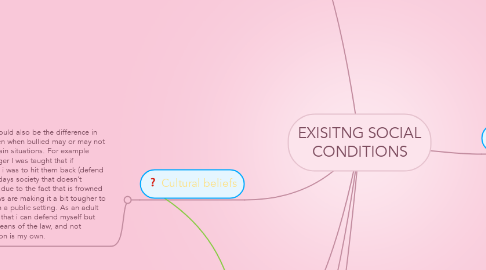
1. PARENTAL SOCIAL STATUS
1.1. Parental social status also directly affects bullying in both parties; a child that is bullied may have things that that bully does not which starts the lashing out process; OR the bully could be lacking basic emotional and physical needs at home based off of the parents social status,as in whether they come from High, middle or lower class status in America.
1.1.1. SOCIAL ROLES
1.1.1.1. PARENTS
1.1.1.1.1. Parents these days play a key part in the rearing of children, their actions, and how they carry themselves. "Social parenting" issues come into play with parents or Men and boys a good amount of the time. Sometimes when child rearing with fathers in the household a childs psychological standpoint is skewed because of the "boy to man" rearing, where a male child must act tough or be rough as they grow older which can alter a childs emotional state. (Sounder, Andre M.D, 2007)
1.1.1.2. EDUCATORS
1.1.1.2.1. Educators on bullying is a fine line in todays society due to the fact that there are some educators that help with trying to lower the amount of bullying that happens at school then there are some educators who simply are the bullies or help to bully children or teens. When it comes to educators on bullying there should be a prevention class done to educate our educators on the effects, warning signs and ways to help and combat bullying before the school year starts. A large-scale study by the NEA and Johns Hopkins University that examined school staff's perspectives on bullying and bullying prevention somewhat refutes that hypothesis, finding 98 percent of participants (all teachers and education support professionals) thought it was "their job" to intervene when they witnessed bullying. But just 54 percent received training on their district's bullying prevention policy (O'Brien,2011).
1.1.1.3. MEDIA
1.1.1.3.1. The media is the biggest silent killer today. Children from the ages 8-18 have so many ways to access social media on multiple devices in the home; however, with that being said it is also a way that bullying can begin without anyone noticing, leaves no traces and can lead some children to hurting themselves or even committing suicide. Social media needs to be toned down or be accessed a lot less by children under the age of 14, and for those over the age of 14 be closely monitored until their mental state can handle the cruel things that people say and do over the internet. This goes back to the role that parents play in the home.

